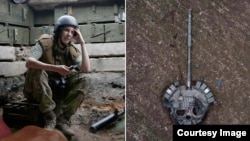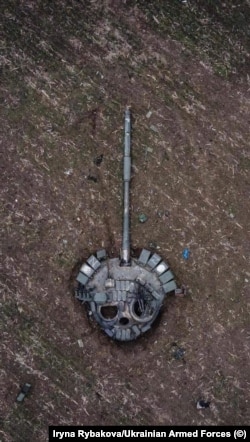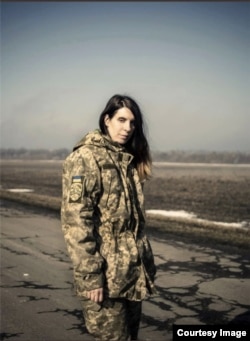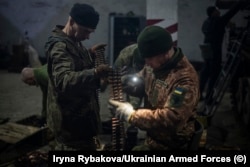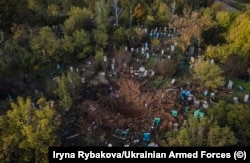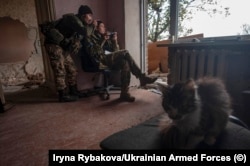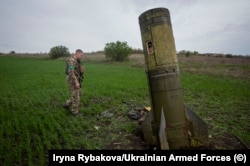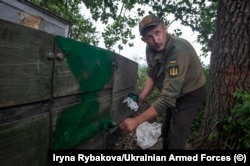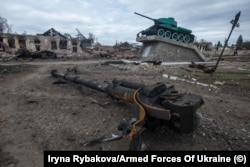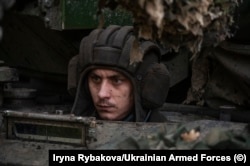Iryna Rybakova's photographs have been published throughout the world's media, yet using her camera is only one part of her job as a junior lieutenant and press officer with the Ukrainian military.
While explaining the circumstances of her most famous photo, Iryna Rybakova interjects a detail that highlights her personal proximity to the Ukrainian war effort.
The above image of a skull-like turret from a destroyed Russian tank, the 38-year-old explains, was made with a drone in March after Ukrainian troops had recaptured the village of Husarivka, in the Kharkiv region, after a bitter fight.
"I just ask you to remember," Rybakova says, "many of my comrades died in that battle."
The photographer then names the soldiers, Yulian Stupak and Oleksandr Garbuz, who were posthumously awarded Ukraine's highest honor for their actions during the recapture.
Rybakova is one of several press officers in the Ukrainian military whose job is to facilitate visits by journalists to frontline positions. The junior lieutenant in the 93rd Mechanized Brigade stands out for repeatedly capturing her own imagery that has become iconic of the war and earned her brigade a massive social media following.
After the tank turret "skull" photo appeared on the cover of The Economist, Rybakova says the image "began to gain wild popularity. It was made into a tattoo, placed on album covers, and made into T-shirts."
More recently, an image Rybakova published in October of an explosion's crater inside a cemetery in Bakhmut was widely shared across social media as an example of the unbounded physical destruction wrought by the Russian invasion. Such frontline aerial images are now rare due to a ban on the civilian use of drones and the high chance that an unidentified quadcopter could be shot out of the sky.
Even with her position in the military, she says she has to take multiple steps before she can fly her DJI Mavic Air 2.
"I inform the battalion leadership that I am going to raise a drone in a certain area, and they warn the positions: At a certain time, in a certain place, our 'bird' is flying," she says.
Rybakova told RFE/RL she began taking pictures in high school when she used her bathroom as a makeshift darkroom. During the 10 years she spent working as a journalist in Ukraine, she maintained photography as a hobby, using a range of devices, including medium-format film cameras that shoot crisp, cracker-sized negatives.
In 2015, when the journalist joined Carpathian Sich, which at the time was a volunteer paramilitary group with links to an ultranationalist political party, Rybakova says her photography skills immediately became useful. She now serves in Ukraine’s 93rd Mechanized Brigade as a press officer and junior lieutenant.
Rybakova says after eight years of low-level conflict in eastern Ukraine, Moscow's full-throated invasion in February came as a shock.
"To be honest, we in the army thought that we would simply go to the borders in place of the border guards, prepare a defensive line, and hold our position for several months," she says. "[We thought] perhaps there would be provocations with shooting from automatic weapons, but nothing more."
The photographer and soldier has felt the full fury of war. On February 26, within minutes of arriving in the newly recaptured town of Okhtyrka in the Sumy region, Rybakova says she dove onto the asphalt as a Russian aircraft dropped what she says was an FAB-3000 bomb on a nearby Ukrainian military position, killing many people.
The 3-ton unguided bomb exploded with such force, she says, it was "as if it was an earthquake or some pit in hell" had opened up. A photo of the aftermath of that explosion shows a water-filled crater the size of a large swimming pool.
When asked about her most vivid experience documenting the war, the photographer’s answer illustrates the pitiless new outlook of many Ukrainians who have watched their country ravaged by the invasion.
"In Okhtyrka on the 24th, the boys met an enemy column and completely destroyed it," Rybakova recalls. "They took me to see dead Russians. One of them was officer Ilyasov, a Buryat by nationality. He was killed by a 19-year-old [Ukrainian] soldier. The corpse was thrown off the road and covered with grass."
"That night I finally slept normally," Rybakova says of seeing the dead officer. "The sight of enemy corpses calmed me down."
